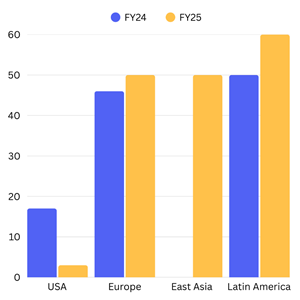New data from the Trade Accelerator Program shows a striking development: half of surveyed companies reported increased trade activity with East Asian markets after completing the program, up from none the year before. Meanwhile, fewer are expanding into the U.S.

For years, the United States has been the go-to export market for Canadian companies. It’s close, familiar, and, until recently, predictable. But today’s trade landscape looks very different, and Canadian businesses are adjusting in real time.
This year’s survey of alumni from our World Trade Centre Toronto Trade Accelerator Program (TAP) shows just how fast things are changing. In 2024, not a single respondent reported increased trade with East Asian markets after completing the program. This year, 50 percent did.
At the same time, fewer companies reported expanding their U.S. trade activity after TAP participation compared to the previous year, a signal that while the U.S. remains a key market for Canadian exporters, it is no longer viewed as the only or primary engine for growth.
That’s not a trend. It’s a turning point.
Canadian SME Trade Expansion by Region: 2024 vs 2025

Percentage of survey respondents reporting increased trade participation following TAP program participation, by year and region
This shift is something we’ve long discussed anecdotally, but now the data is catching up. As WTC-T VP Jon Worren observed:
“Those who are currently exporting are predominantly trading with the U.S. For many, their first foray resulted from a meeting at a trade show, or simply an unsolicited call looking for a product supplier. Proximity and shared language make it easy. But opportunistic doesn’t always equate to strategic.”
That distinction, between opportunistic and strategic, is becoming clearer. Canadian SMEs still trade with the U.S., but they’re increasingly focused on growth opportunities elsewhere, with greater intention and long-term vision.
Turning Away from Uncertainty
Canadian small- and medium-sized enterprises (SMEs) are recognizing the risks of relying too heavily on a single market. With protectionism on the rise in the U.S. and trade policy shifting with each election cycle, many businesses are thinking twice about expanding south of the border. In fact, fewer respondents this year reported any growth in U.S. trade activity at all.
The message is clear: the ground under our largest trade relationship is no longer as firm as it once was.
A New Centre of Gravity
In contrast, East Asian markets are becoming a new focus, including Japan, China and Hong Kong, Singapore, Vietnam and Taiwan. These are economies that are open to Canadian business, backed by trade agreements like the Comprehensive and Progressive Agreement for Trans-Pacific Partnership, and positioned for long-term growth.
More importantly, they offer something Canadian SMEs are looking for right now: stability.
But success in these markets isn’t one-size-fits-all. As participants in our recent Global Growth Series webinar noted, expansion strategies must reflect the character of each market.
“What works in Vietnam won’t work in Taiwan. The right strategy starts with knowing the difference.”
In emerging economies like Vietnam, the path to growth often depends on building in-country partnerships that can help navigate local legal systems, government processes, and supply chain logistics. Hiring local talent, especially in roles like project management, can also be a critical success factor.
In contrast, advanced markets like Taiwan offer opportunities for strategic or technical partnerships, particularly in areas like research and development, pilot projects, and high trust supply chains. These markets are also well positioned for innovation-oriented companies looking for IP-sensitive collaborators.
Importantly, the region is deeply interconnected. Many Taiwanese firms maintain strong supply relationships in Vietnam. For Canadian SMEs, this means an entry into one market often opens doors in another.
What Comes Next
This pivot to East Asia doesn’t mean giving up on the U.S. But it does suggest that Canadian exporters are embracing a more balanced, diversified approach: one that guards against sudden shocks and creates new growth opportunities.
And while trade knowledge and ambition matter, so does support. Many of the most successful exporters emphasized the importance of trusted partnerships with local firms, with other Canadian companies operating in the region, and with in-market support from organizations like the Trade Commissioner Service and Global Affairs Canada.
This kind of ecosystem support often makes the difference between a stalled expansion and a successful one. Building a strong local network must be part of the strategy.
What This Shift Says About the Future
This shift toward East Asian markets isn’t just a tactical response to a turbulent moment, it’s the early signal of something larger. Canadian SMEs are re-evaluating their global strategies, and the results are already reshaping where and how trade happens. What began as a risk-management move is quickly evolving into a new model for international growth – one that prizes resilience, regional integration, and smarter engagement with fast-growing economies. The momentum is real, and it’s only building.
If you're exploring new markets or looking to strengthen your international approach, the Trade Accelerator Program can help. Learn more at bot.com/TAP.

